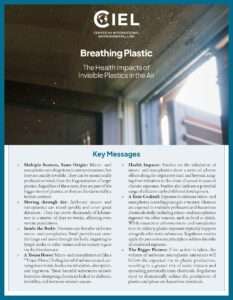
As the world’s understanding of the plastics crisis grows, new facets of the problem emerge and reveal impacts on human health and the environment. Recent advances in science are allowing scientists to explore how micro- and nanoplastics form a critical piece of the plastic pollution problem. First thought to be mainly a marine pollution issue, over the last decade, scientists have discovered micro- and nanoplastics exist in every environmental compartment — from freshwater to soil and air — and in thousands of species, including humans. But like climate change and hazardous chemicals, most plastics are invisible to the naked human eye, meaning their impact goes relatively unseen.
Contrary to popular depictions, oceans are not “the final sink” for microplastics. These tiny plastic particles can travel worldwide, ending up in urban, rural, and remote areas. They take an even faster transport pathway than oceanic currents: the atmosphere.
Breathing Plastic: The Health Impacts of Invisible Plastics in the Air analyzes the implications of micro- and nanoplastics moving through the air and entering the human body via inhalation.
The brief explores the problem of ubiquitous tiny plastic particles in the atmosphere, reveals how airborne micro- and nanoplastics are part of the larger story of plastics, and compiles evidence of the wide-ranging health impacts that result from inhaling plastics. It concludes by warning about the growth trends in plastic production and offering recommendations for decision makers to address the threat of airborne microplastics by taking a life-cycle approach to confronting the plastics crisis.
Read the brief.
Read the summary.
Published March 27th, 2023
